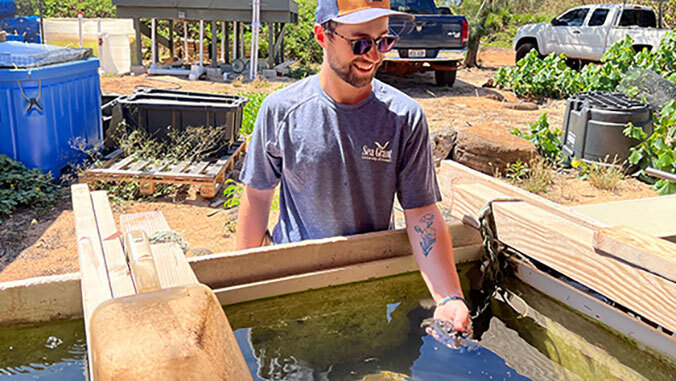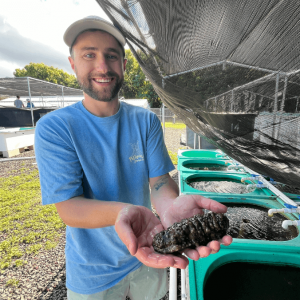
In ancient Hawaiʻi, fishponds were remarkably successful in ensuring a steady supply of food. Yet, efforts to revitalize this traditional aquaculture have encountered challenges. With biennial University of Hawaiʻi Sea Grant College Program awards totaling $315,759, two new aquaculture projects led by College of Tropical Agriculture and Human Resources Andre Seale are addressing these problems.

Seale’s studies employ two local species for sustainable aquaculture development: the sea cucumber (Stichopus horrens) and ʻamaʻama, or striped mullet (Mugil cephalus). His team also includes graduate assistants Tyler Goodearly and Reilly Merlo, who are enrolled in the Nutritional Sciences PhD program, as co-investigators.
Sea cucumbers
To improve the productivity of sea cucumbers, Seale and Goodearly will partner with local producers, fishpond managers and collaborators to devise a species-specific approach for inducing spawning behavior while assessing the viability of larvae. The researchers hope the knowledge gained will provide a framework for overcoming the reproductive dysfunction of sea cucumbers and reliably producing them in Hawaiʻi. Ultimately, it could spearhead national sea cucumber production efforts and lead to practices that will optimize growth in sustainable aquaculture systems, including Hawaiian fishponds.

“This sea cucumber is a good candidate for aquaculture, given its fast reproductive life cycle, ecosystem services rendered as sediment feeders and high value in Asian markets,” said Seale, of the Department of Human Nutrition Food and Animal Sciences.
ʻamaʻama
Natural recruitment of the striped mullet to fishponds has become unreliable, and the introduction of hatchery-raised fry directly into the fishponds has been largely unsuccessful.
In order to better understand how to improve rearing practices and stock enhancement of this species, this project aims to establish strategies to adjust the fingerling hatchery environment to improve its environmental resilience, and optimize survival and growth once introduced to a Hawaiian fishpond setting.
Seale and Merlo will focus on the effects of variable salinity and temperature regimes on physiological markers of growth, stress and salt-and-water regulation in the fish. This will help establish which environmental conditions can best prepare the juvenile mullet for survival in the natural fishpond setting.
“In addition to informing management strategies for rearing the ʻamaʻama in fishponds, the results should also provide further insight into how these native fish might adapt to future changes in climatic conditions,” said Seale.


